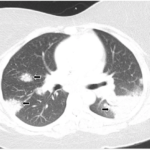I thought back to the first day of an elective surgical rotation when I was a fourth-year medical student. The surgeon at the small southern community hospital brusquely shook my hand and said, “Internal medicine? You’re going into internal medicine instead of surgery?”
“Yes,” I said.
“You’re going to be a flea,” he drawled.
“A flea?”
“That’s right, a flea. The first to jump onto a patient and the last to get off.”
“Well,” I stammered, “that’s a good thing, isn’t it?” In internal medicine and in the practice of rheumatology, sometimes the answers don’t come easily. You’ve got to dig.
Second Opinion
Although her joint and muscle pain were only marginally improved with daily meloxicam, Mrs. N stoically refused a trial of prednisone. I sent her south for a second opinion at the Lahey Clinic in Boston. She wanted answers.
The Lahey Clinic rheumatologist suggested that Mrs. N was suffering from adult-onset Still’s disease, a rare, systemic subset of childhood arthritis that has been described in adults.
I’d considered Still’s during Mrs. N’s first hospitalization, but didn’t feel she fit the criteria for the diagnosis. Again, like so many disorders in rheumatology, there is no single conclusive test to confirm adult-onset Still’s disease. The daily fevers and intense muscle and joint pain certainly fit the bill, as did the dramatically elevated inflammatory markers—the sedimentation rate and C-reactive protein. But patients with Still’s disease also demonstrate an evanescent salmon-colored rash with the daily fevers, which Mrs. N lacked. My mind was open to the possibility of Still’s, but without the rash (the rash is so singular, it’s called a Still’s rash), we both agreed this was only one possibility among many.
Medication Trials
Mrs. N acquiesced to a trial of weekly injectable methotrexate, but was, at most, 10–20% better after eight weeks, and she discontinued the drug on her own. The sedimentation rate and C-reactive protein levels redlined as if she were taking nothing whatsoever.
Without a specific diagnosis, Mrs. N wanted to hold off on prednisone. I argued—once again—that we could easily manage elevated blood sugars if they spiked on prednisone and further, there were medications to maintain or improve bone strength if prednisone was necessary long term.
Her reply: “So you’re going to give me prednisone and two other medications for a disease you can’t name, for a duration you can’t guess, with side effects worse than the disease.”


